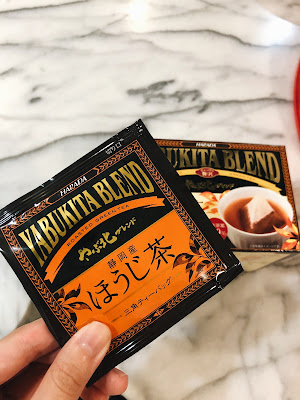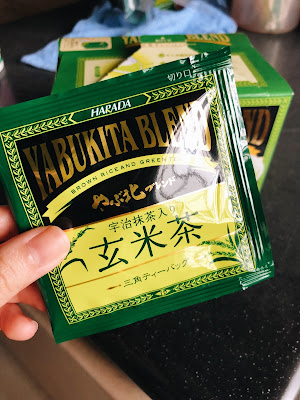Apart from the Teapig’s Snooze tea, I also picked up Harada’s Yabukita Blend teas at Cafe Asia. To be honest, a large part of why I bought the teas was because the people selling them were Japanese and it was fun to speak to them. That and at $5 a box, the teas were reasonably priced to me.
So I googled and Yabukita (やぶ北) is a type of tea plant and it makes up about 77% percent of the Japanese green tea produced in Japan [1]. These teas are Yabukita blend teas, which apparently make up 80% of the green tea market [2], which means that it’s really popular and can be said to be a green tea that represents Japanese green tea. In this particular blend, yabukita tea makes up over 30% of the green tea or houjicha. Now on to the tea reviews!
Houjicha (ほうじ茶)
Despite its brown colour, Houjicha is a type of green tea. The colour and taste comes from the roasting of the tea leaves. Its ranking (because apparently teas have ranking) is below that of Gyokuro and Sencha. That said, it’s a delicious tea. This particular brand of houjicha has a strong smoky taste and is very smooth and easy to drink. Everyone in my family loves it, even those trying it for the first time, and they praised both the taste and the aroma.
Oh, and incidentally, Houjicha has less caffeine (about 20mg for 150ml of tea) compared to Gyokuro (180mg), sencha (30mg), and matcha (50mg), which would make it good for a late afternoon/night drink if you’re sensitive to caffeine [3]
This houjicha is made from tea produced in Shizuoka! Shizuoka is one of top produces of tea in Japan, producing 40% of Japanese tea[4]. And although the tea I bought is houjicha, Shizuoka is actually famous for fukamushicha (深蒸し茶), where the tea is steamed twice as long as regular sencha, resulting in a unique colour and taste, as well as supposedly being healthier [5]. But if you’re buying Shizuoka tea, you may want to check if the tea is made solely from leaves produced in Shizuoka or if it’s a Shizuoka blend, which means that 1% to 49% of the tea leaves can be produced outside the prefecture (not saying that the tea will be inferior, but if you want to buy pure Shizuoka tea you should be looking out for this keyword) [6].
Genmaicha (玄米茶)
The other tea that I bought is this genmaicha with Uji matcha. Uji tea is one of the three big teas in Japan and their matcha is particularly famous. And again, I did not get the tea that Uji is famous for. Genmaicha is green tea that has rice which was steamed and then toasted added in [7]. Apparently, this came about during pre-war times (Wikipedia was not specific about which war, although I’m assuming WWII), when tea dealers didn’t want to waste the bits of new year mochi they had lying around and decided to toast it and add it to tea. Like houjicha, genmaicha is not considered a ‘fancy’ or high SES tea.
For some reason, both the smell and taste of this tea reminded me of toasted seaweed. It’s definitely a savoury tea, which isn’t really my cup of tea. I do quite like it hot, but I can’t stand it when it’s room temperature or lukewarm (a possibility since I’m drinking this at work), while I’m normally fine with teas at any temperature.
According to the box, you should use boiling water for this tea, steep for 30 seconds, and move the teabag back and forth gently before removing it (this is for both teas). They use pyramid teabags [8], which is supposed to make it easy for the leaves to unfurl, giving it a better taste.
Conclusion: While I’d definitely get the houjicha if I see it again, I’m not so sure about the genmaicha.
Notes
[1] Teapedia’s Yabukita page. I’ve also seen the numbers 75% (Japanese Wikipedia) and 76% (Harada’s Webpage) cited.
[2] According to the Japanese Wikipedia on Yabukita.
[3] I got my info from the table on this page, which is basically talking about the amount of caffeine in various Japanese teas.
[4] According to Shizuoka Prefecture
[5] Information from 日本一の生産量を誇る静岡のお茶の特徴とは
[6] This is information from the Japanese Wikipedia page for Shizuoka tea.
[7] According to お茶百科
[8] Well, the box says “tetra” but it’s the same thing to me.



